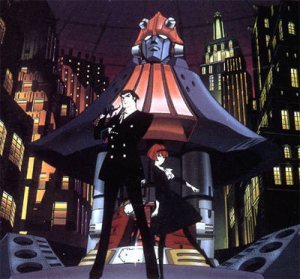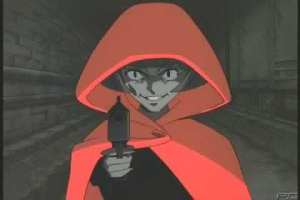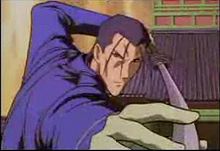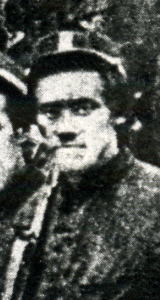What are memories? Are they something we need to establish an identity or are they haunting enigmas that plague us when we go to bed at night? These philosophical questions are probably strange to you and me, but to the characters in the Japanese animated (anime) series, The Big O, the nature of memories is both haunting and an enigma. Something happened forty years ago to humanity, when millions of people were mysteriously wiped out; those that survive lost their memories about who they are and what they did. Basically, the survivors had to, not only rebuild their societies, but had to rebuild their identities as well. Throughout, The Big O, memories are often treated like ghosts or nightmares. In other words, memories can be dangerous, especially if, it is something someone does not want others to know about. In the, The Big O, the strange and dangerous nature of memories are what drive this unique, yet sometimes confusing show.
The Big O is about Roger Smith, a negotiator by day, but by night, is a pilot of a giant Megadeus (robot) called Big O. Aiding him, in his quest to protect Paradigm City (supposedly, the only city with people left on Earth), are R. Dorothy Wayneright (an android who works lives with Roger Smith and acts like a maid), Norman Burg (Roger Smith's butler), Dan Dastun (a major in Paradigm City's military police force), and Angel (a mysterious woman with her own agenda). While, The Big O appears, at first glance to be another show about giant robots destroying each other; in reality, it's a complicated psychological mystery mixed with humor and action. In some ways, the highlight of the series is the dynamic relationship between Roger and Dorothy (see picture of them below).
Roger and Dorothy have different personalities, which sometimes causes tension between the two (i.e. Roger likes to sleep him and Dorothy will play the piano in a way that annoys Roger so much, he took her to an android who plays the piano to teach her how to play correctly). Often, Dorothy will call Roger a "louse" because has done something to annoy her. An example of this happens when Roger uses her as a distraction, while he calls on Big O to stop some rocket launching thieves, needless to say Dorothy ends up getting messed up and she blames Roger for it. Hence, the origin of why Dorothy calls Roger a "louse" when she is irritated. Despite their personality differences, Roger and Dorothy do care for each other and by the end of the series, there is evidence that suggests that Roger has fallen in love with Dorothy; Dorothy may also have fallen in love with Roger, but that is a little harder to prove because she is an android and she hides her feelings and emotions well.
The episode (referred to as RD) I have selected is not an episode I would normally show a person who wants to see lots of Roger and Dorothy interaction; Roger and Dorothy do not talk to each other until the end of the episode. However, the reason I picked this episode is because the director, Kazuyoshi Katayama, crafted a really good murder mystery where we are led to believe that Dorothy is the killer of a group of young men and women who claim to have memories of what happened forty years ago. Roger is drawn into this mystery when one of his clients is killed by a mysterious figure in red; we later learn that her name is RD or Red Destiny (see picture below) and she interestingly enough, is a similar android model to Dorothy and has been programmed to kill people on a certain list with bar codes that Roger found. Later on, in the series, we find out that Alex Rosewater, the de facto ruler of Paradigm City, ordered RD to kill the people on the list with the bar codes. RD is destroyed by Big O and we the audience discover that Dorothy is inside the megadeus.
Overall, the strange and dangerous nature of memories that are represented in The Big O are what fuel this unique, yet sometimes confusing show. The interaction and personality clashes between Roger Smith and R. Dorothy Wayneright is what makes this show click with the audience in my opinion because it is funny to see Roger get angry with Dorothy for playing the piano wrong or when Dorothy calls Roger a "louse" for annoying her because they remind you of a married couple, even though Roger is human and Dorothy is an android. Who knew living with an android would be so hard! Episode 13, entitled RD, is not the best episode for people who like to see Roger and Dorothy annoying each other, but is nevertheless, a good episode filled with mystery and suspense. In the end, The Big O is a great anime with lots of mystery, action, giant robot fun, and humor.






